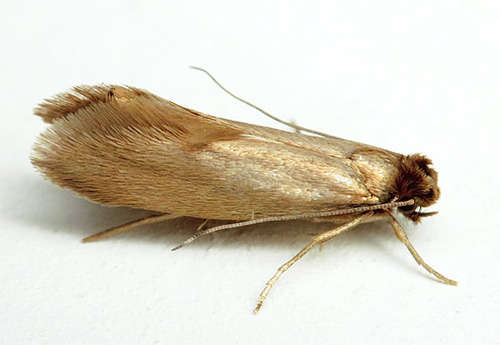
Clothes and furniture moths have long been known to spoil clothes, fur and wool products, furniture upholstery and carpets. At the same time, the furniture moth prefers fur, furs and wool, and the clothes moth prefers mainly cotton products. In nature, both species are pronounced keratophages - that is, they feed on animal hair and feathers, and in an apartment they can easily switch from one diet to another.
It is interesting
Among the moths there is a butterfly whose caterpillars gnaw holes in the horns of African antelopes and live in them, feeding on keratin.
In the past, both of these types of room moths were called generically - clothes moths, and even today this habit has been preserved among the people, although the butterflies themselves are quite easily distinguished from each other. Therefore, later in the text, when describing the general features of biology, both species will be referred to as clothes moth, and if clarification is required, this will be discussed separately.
First look at clothes and furniture moth
Both types of moths are quite similar to each other. Adult butterflies are small - they reach 5-9 mm in length with folded wings, and have an inconspicuous straw-yellow color. The furniture moth may be somewhat darker, and it also has slight darkening at the base of the wings.
The clothes moth is almost always light yellow. With the naked eye, the differences between these species are difficult to catch.For example, in the photo below - clothes moth:
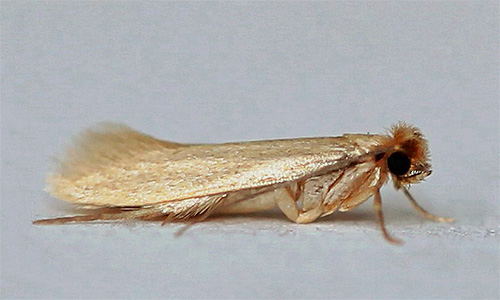
And in the next photo - furniture moth:
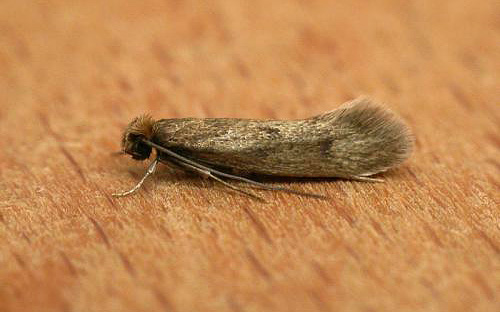
In the air, a furniture moth looks like a small and not the most skillful moth in flight. Only males fly in both furniture and clothes moths. The females have wings, but they do not use them.
It is interesting
The opinion that female room moths are wingless is not true. Any indoor moth has winged females and males. The wings of females are only slightly smaller than those of males, and in principle, females are able to fly. But this ability is not used as unnecessary - the males find them themselves, fertilize them, and the females lay their eggs without long-distance movements.
An inexperienced eye is unlikely to be able to find differences between male and female clothes moths. From the food moth, for example, the barn moth or the mill moth, the clothes moth differs precisely in the uniform color of the wings. All types of moths have a fairly conspicuous pattern on the wings.

But the most important pest is not the butterfly moth at all. The direct destroyer of clothes and furniture upholstery are clothes moth larvae - inconspicuous little caterpillars that carefully and quickly gnaw holes in sweaters, fur coats and bald patches on carpets.
Moth larva and eggs: how and where to find them
So, it is the moth larva that feeds on our clothes. From wool and cotton, the caterpillar is able to draw out the minimum of nutrients that are there, and for this it has all the necessary devices:
- sufficiently strong and long mandibles - two large outgrowths that act as scissors for cutting fabric fibers and fur hairs. Each of them has several teeth that increase the gnawing capabilities of the caterpillar.
- Powerful jaw muscles - almost the entire head - thanks to which the caterpillar can develop enough pressure to gnaw matter.

- Huge, in comparison with the size of the body, the stomach and intestines, in which a large amount of food can accumulate.
At the same time, the larvae of the furniture moth differ well from the larvae of the clothes moth. The clothes moth larva can build a simple little cover from its own secretions and food debris, while the furniture moth caterpillar builds a well-marked and durable corridor along the entire route of its movement.
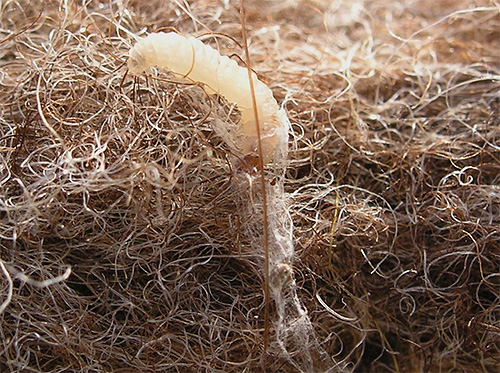
In the photo below - the larva of the clothes moth. It retains this whitish-yellow color throughout its development:

The caterpillars of the room moth are quite inactive. Only after hatching from eggs, they spread over small distances from each other, but after the start of good nutrition, they move very little.
It is interesting
Clothes moth caterpillars diligently avoid light. If you bring the clothes with them into the light, they try to hide among the folds or in their covers.
If the food is quite suitable for room moth larvae (contains little or no synthetics), they grow rapidly, and in 18-20 days they manage to molt 12-13 times, after which they pupate. If the caterpillars have to eat low-nutrient food (for example, with a high content of indigestible synthetic fibers), then in most cases development is delayed up to 1-2, and sometimes up to 6 months.
On a note
The development of room moth larvae also slows down in the case of a decrease in air temperature in the place of their presence.At the same time, the caterpillars themselves become smaller, and when certain temperatures are reached, they hide in cocoons and stop eating.
The eggs of indoor moth species are white or whitish-yellow in color, small and do not exceed 0.5 mm in length. The female lays them in small groups of 50-80 pieces directly on clothes or other fabric, which the larvae will subsequently feed on.
An example of laying eggs of clothes moth is shown in the photo below:

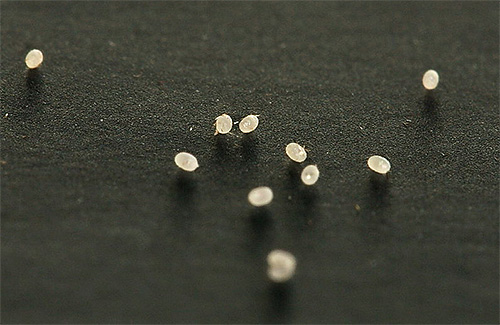
The eggs of clothes and furniture moths develop within 5-6 days, but when the air temperature drops, this period is delayed, and when it reaches 0 ° C, the eggs die altogether.
Moth nutrition and the main harm from it
Adult clothes moth butterflies do not feed at all. Their mouth apparatus and digestive tract are underdeveloped, and they do not need food.
By the way
Butterfly moths live on the strength of several weeks, more often - 8-10 days. Usually, females lay eggs on the third or fourth day after leaving the pupa, after which they die rather quickly.
Moth larvae feed almost in the same place where they hatch from eggs. Any natural fabric, fur, wool is suitable for food, they often parasitize on museum stuffed animals and in warehouses of textile raw materials.
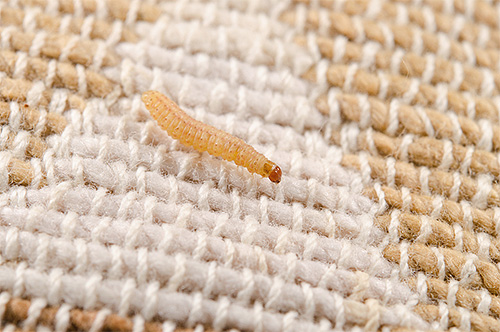
Moth larvae feeding on fur things cannot move freely in wool. Therefore, on the way of their movement, they have to gnaw hairs of fur that they do not eat, leaving a clipped path and a bunch of hairs on their clothes.
Moth caterpillars cannot eat fully synthetic things. If the fabric consists partially of synthetics, then it can be eaten by the larva, but on such a diet the caterpillar grows much more slowly than on natural fabrics.
Reproduction and lifestyle of the pest
After leaving the chrysalis, male clothes moths begin to diligently look for the female, orienting themselves, first of all, by smell. After mating, after 3-4 hours, the female begins to lay eggs. She lays them in portions, while the furniture moth is much more prolific - one female can lay up to 300 eggs, while in a female clothes moth this number barely reaches 60.
The clothes moth has no seasonality in development and reproduction. Larvae from the same clutch can develop at different rates, and the emergence of butterflies from larvae occurs unevenly and separately. In nature, all species of mid-latitude moths have a period of hibernation, usually pupae or caterpillars of the last ages hibernate.
Fighting moths: are there really reliable means?
Today, there are a large number of ways to get rid of clothes moths, both traditional and fairly modern. The most effective among them are the following:
- Treatment of clothing with insecticidal preparations in aerosol form. Such tools allow you to quickly destroy the larvae and butterflies at any time of the year.

- Freezing out infected clothing and furniture outdoors at temperatures below minus 5 ° C, or warming it up in the sun on a hot summer day with preliminary thorough shaking - the larvae weakly adhere to the surface of clothing and easily crumble.
- Washing clothes at the maximum temperature allowed for it.
- Use of insecticidal fumigators installed in cabinets.
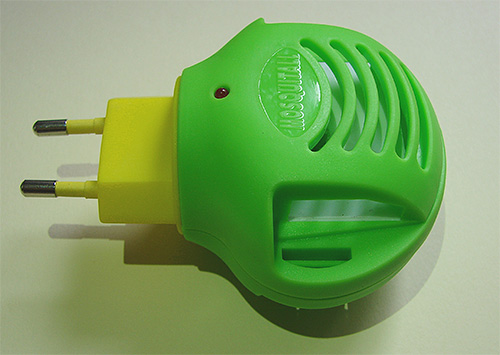
To protect cabinets and wardrobes from moths, strong-smelling herbs are used - tansy, lavender flowers, rosemary, as well as orange peels, tobacco, special industrially produced moth sections with various odors.Laid out in cabinets, they are able to quite reliably scare away adult butterflies. It is only important to understand that such odorous agents do not affect the larvae.
But the most reliable way to prevent moths from breeding on things is a thorough quarantine: checking new purchases, carefully washing new clothes at high temperatures, avoiding purchases “from hand” and second-hand stores. After all, it is always easier to prevent the appearance of a pest in an apartment than to get rid of it later.
Useful video: how to get rid of moths?



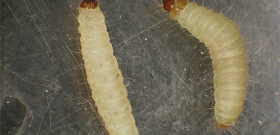

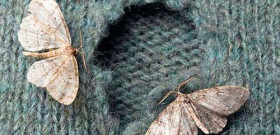
Cool article!